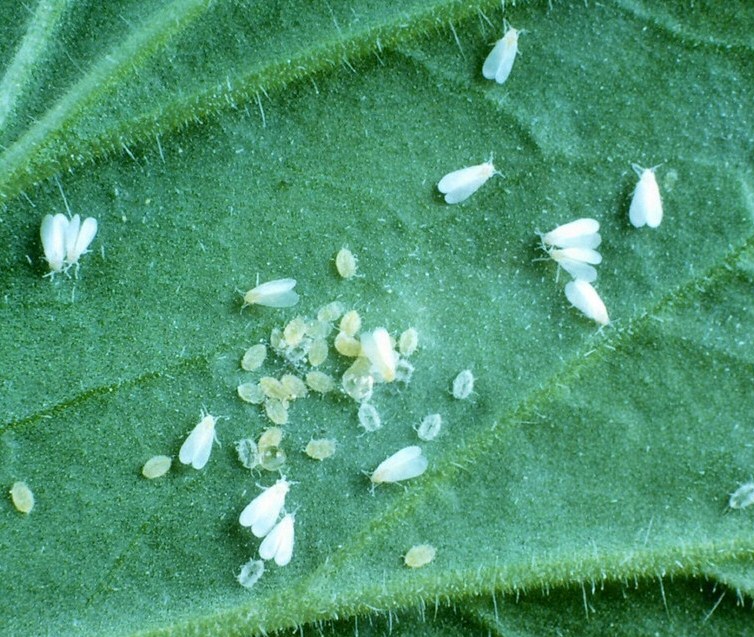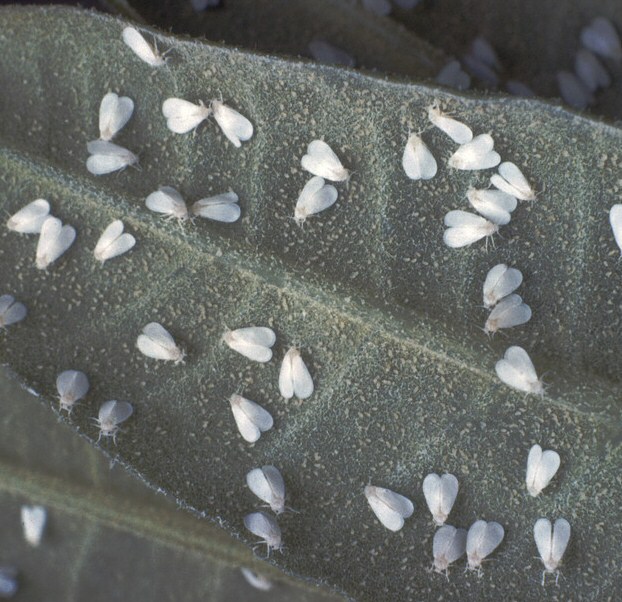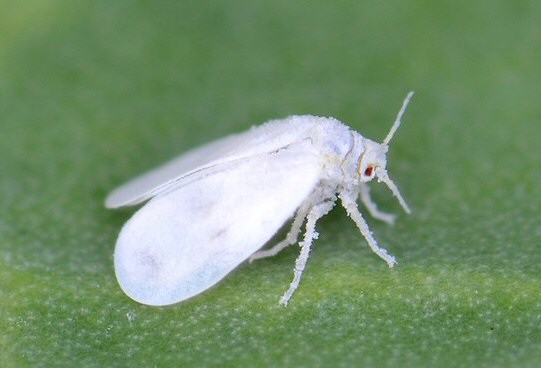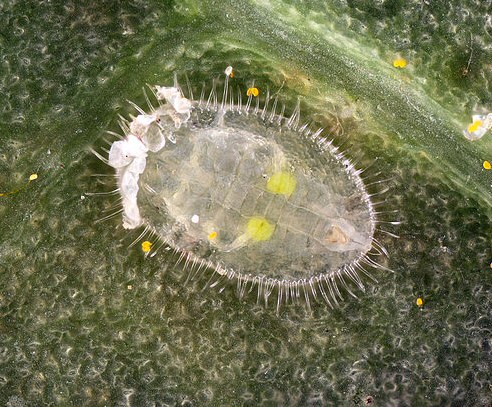- Home
- Garden Wildlife
- Insects
- Hemiptera
- Whiteflies
Whiteflies
Whiteflies are tiny sap-sucking insects in the family Aleyrodidae of the order Hemiptera, suborder Sternorrhyncha. They are 1-2mm long with wings that are covered in a white waxy powder. When at rest, the adults resemble tiny moths. The immature nymphs are mainly whitish yellow and have a scale-like appearance.
Species in Britain and Ireland
There are about 11 species of whitefly in Britain and Ireland, most of which are non-native species that occur on garden plants or in greenhouses. The most common species are glasshouse whitefly, Trialeurodes vaporariorum, found on a wide range of plants in greenhouses and on house plants, and the native cabbage whitefly, Aleyrodes proletella, on various brassicas. Other species commonly found in gardens are viburnum whitefly, Aleurotuba jelineckii, on Viburnum tinus and Arbutus species; azalea whitefly, Pealius azaleae, on evergreen azaleas; honeysuckle whitefly, Aleyrodes lonicerae, on honeysuckle and strawberry.


Cabbage whitefly Aleyrodes proletella 1-2mm Rhododendron whitefly Dialeurodes chittendeni
Biology
Whitefly adults and nymphs feed by sucking sap from the underside of leaves on their host plants. They excrete a sugary honeydew that coats the upper surface of leaves. This makes them sticky and allows the growth of black sooty moulds. The immature nymphs are immobile once they have found a suitable feeding place. The adult insects readily fly up when disturbed.
Life cycle
Glasshouse whitefly have many generations a year and will continue reproducing throughout the winter. Other species on outdoor plants have one or more generations, with reproduction confined to the summer months. At least some species reproduce parthenogenetically without males, and all male whitefly arise from unfertilised eggs. Eggs are deposited on the underside of leaves, sometimes in a circular pattern. These hatch into flattish oval-shaped nymphs that increase in size as they mature. They pass through a pupa-like final nymphal stage that retains the previous instar cuticle as a protective dry structure called a puparium. The puparium often has filaments arising from it, or waxy encrustations.


Other sources of information
Scientific paper
Malumphy, Chris & Badmin, John. (2012). Scale insects and whiteflies (Hemiptera: Coccoidea and Aleyrodoidea) of Watsonian Kent; with a discussion on the impact of naturalised non-native species. British Journal of Entomology and Natural History. 25. 15-49.
Page drafted by Andrew Halstead, reviewed by Andrew Salisbury, edited by Steve Head
Nymphal stage of glasshouse whitefly Tryaleurodes vaporiacum. It is only about 2mm long.
"Nymphs" like this are so different from the adult (and require a pupal-reorganisation instar) that many entomologists use the term "larva" instead. See incomplete metamorphosis.
Most outdoor species of whitefly overwinter as nymphs or as puparium nymphs. The overwintering stage of viburnum whitefly has distinctive black pupae surrounded with a white waxy fringe. Cabbage whitefly overwinter on their host plants as adult insects.
Role of whiteflies in gardens
With the exception of glasshouse and cabbage whiteflies, garden plants affected by other species of whitefly usually show no signs of ill effects and can tolerate these insects. Glasshouse whitefly can cause problems on glasshouse plants and cabbage whitefly can be a problem on brassicas. Commercial growers employ biological control using parasitic wasps, beetles or fungi. The honeydew produced by whiteflies and their nymphs is an energy-rich food source that is used by various other insects.
Glasshouse whitefly adults and nymphs
Whiteflies
Whiteflies are tiny sap-sucking insects in the family Aleyrodidae of the order Hemiptera, suborder Sternorrhyncha. They are 1-2mm long with wings that are covered in a white waxy powder. When at rest, the adults resemble tiny moths. The immature nymphs are mainly whitish yellow and have a scale-like appearance.
Species in Britain and Ireland
There are about 11 species of whitefly in Britain and Ireland, most of which are non-native species that occur on garden plants or in greenhouses. The most common species are glasshouse whitefly, Trialeurodes vaporariorum, found on a wide range of plants in greenhouses and on house plants, and the native cabbage whitefly, Aleyrodes proletella, on various brassicas. Other species commonly found in gardens are viburnum whitefly, Aleurotuba jelineckii, on Viburnum tinus and Arbutus species; azalea whitefly, Pealius azaleae, on evergreen azaleas; honeysuckle whitefly, Aleyrodes lonicerae, on honeysuckle and strawberry.


Cabbage whitefly Rhododendron whitefly
Aleyrodes proletella 1-2mm Dialeurodes chittendeni
Biology
Whitefly adults and nymphs feed by sucking sap from the underside of leaves on their host plants. They excrete a sugary honeydew that coats the upper surface of leaves. This makes them sticky and allows the growth of black sooty moulds. The immature nymphs are immobile once they have found a suitable feeding place. The adult insects readily fly up when disturbed.
Life cycle
Glasshouse whitefly have many generations a year and will continue reproducing throughout the winter. Other species on outdoor plants have one or more generations, with reproduction confined to the summer months. At least some species reproduce parthenogenetically without males, and all male whitefly arise from unfertilised eggs. Eggs are deposited on the underside of leaves, sometimes in a circular pattern. These hatch into flattish oval-shaped nymphs that increase in size as they mature. They pass through a pupa-like final nymphal stage that retains the previous instar cuticle as a protective dry structure called a puparium. The puparium often has filaments arising from it, or waxy encrustations.


Nymphal stage of glasshouse whitefly Tryaleurodes vaporiacum. It is only about 2mm long.
"Nymphs" like this are so different from the adult (and require a pupal-reorganisation instar) that many entomologists use the term "larva" instead.
Glasshouse whitefly adults and nymphs
Most outdoor species of whitefly overwinter as nymphs or as puparium nymphs. The overwintering stage of viburnum whitefly has distinctive black pupae surrounded with a white waxy fringe. Cabbage whitefly overwinter on their host plants as adult insects.
Role of whiteflies in gardens
With the exception of glasshouse and cabbage whiteflies, garden plants affected by other species of whitefly usually show no signs of ill effects and can tolerate these insects. Glasshouse whitefly can cause problems on glasshouse plants and cabbage whitefly can be a problem on brassicas. Commercial growers employ biological control using parasitic wasps, beetles or fungi.The honeydew produced by whiteflies and their nymphs is an energy-rich food source that is used by various other insects.
Other sources of information
Scientific paper
Malumphy, Chris & Badmin, John. (2012). Scale insects and whiteflies (Hemiptera: Coccoidea and Aleyrodoidea) of Watsonian Kent; with a discussion on the impact of naturalised non-native species. British Journal of Entomology and Natural History. 25. 15-49.
Page drafted by Andrew Halstead, reviewed by Andrew Salisbury, edited by Steve Head












